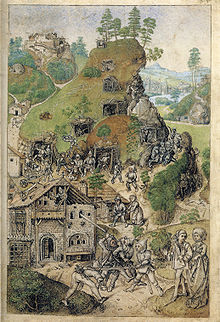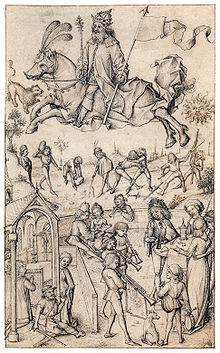Master of the Amsterdam Cabinet, Holy Family in a Garden

Venus and Mars, drawing with watercolour from the "Housebook", with a mine in the groundwork.

The Dominicus and his children, cartoon from the "Housebook"
Chief of the Housebook and Principal of the Amsterdam Cabinet are two names used for an engraver and painter working in Southward Germany in the last quarter of the 15th century. He is plainly the first artist to use drypoint, a form of engraving, for all of his prints (other than woodcuts he may take designed). The start proper name derives from his book of drawings with watercolour, called the Housebook, which belonged to the High german noble family unit of Waldburg-Wolfegg from the 17th century until 2008, when they were reported to have sold information technology for €20 1000000 to a Swiss buyer;[1] however, the legality of its auction for export has been challenged and, for the moment, it remains with the family. In 1999, the volume was lent to the National Gallery of Art in Washington, D.C., for an exhibition. [1] The majority of his surviving prints are in the impress room at the Rijksmuseum in Amsterdam, hence his 2d name. About, only not all, art historians withal concord that the Housebook and the prints are by the aforementioned artist.[2]
Work [edit]
His ninety-1 prints are extremely rare, with threescore surviving in one impression (copy) but, and none in more than than five – in that location are a full of 124 impressions, eighty in Amsterdam.[3] It is thought that because his prints were made using only the shallow, scratched line of drypoint, probably on tin or a pewter-type alloy, simply ten to xx impressions of each could exist taken earlier the plate wore out.[4] Many engravings past other artists are believed to exist copies of missing works by this primary. In particular, Israhel van Meckenem seems to have copied more than 30.
His piece of work is very well drawn and lively, with the interest in detail typical of Early Netherlandish painting.[5] Arthur Mayger Hind notes of his way that "he is an artist with a liberty of draughtsmanship quite remarkable at this epoch. If his manner of engraving has something of the irregularity of an amateur, his ability of expression is vigorous and masterly."[six]
A high proportion depicts secular subjects, more than is typical with artists of the period. Along with his contemporary Martin Schongauer, the Housebook Master was the leading artist making one-time master prints in Germany in his catamenia. Both Schongauer and the Housebook Master had a considerable influence on the prints of Albrecht Dürer.[seven] The Master suggests Netherlandish influence in the modelling of low-cal and shade and in some of his figural types.
A small number of paintings are likewise thought to be his work, notably the Pair of Lovers in Gotha, the Speyer Altarpiece (divided amongst Gemäldegalerie, Berlin, the Städel, Frankfurt, and Augustiner Museum Freiburg, and the Holy Family unit (Nuremberg, Germanisches Nationalmuseum, since 2004). Nonetheless, many scholars feel the Gotha Lovers and the Speyer Altarpiece cannot be past the same artist, and favour attributing but the Lovers to the Housebook Master. Others disagree, and attribute the engravings and the altarpiece to the same master.[8]
Erhard Reuwich? [edit]
It was first suggested in 1936 that he should be identified as Erhard Reuwich of Utrecht, an artist and (or) printer working in Mainz, who designed and signed an influential 5-foot-long (1.v one thousand) woodcut panoramic view of Venice made following a visit in 1483 or 1484 during a pilgrimage to the Holy Country.[ix] Reuwich printed the business relationship in Latin of the trip, the Sanctae Peregrinationes by Bernhard von Breydenbach of 1486, in which the woodcut was the outset ever fold-out plate. The pattern was later on adapted by Michael Wolgemut for the Nuremberg Chronicle. Reuwich was taken every bit an artist in the entourage of Breydenbach, a wealthy catechism of Mainz Cathedral. The volume likewise contained panoramas of six other cities, including Jerusalem[two], studies of Near Eastern costume, and an exotic alphabet - the start in print.[three] [4] It was a bestseller, reprinted xiii times over the next 3 decades, including editions printed in France and Spain, for which the illustration blocks were shipped out to the local printers.

Lover'south Garden, drawing from the "Housebook"
In 1485 Reuwich drew some plants for the woodcuts in a herbal also published in Mainz.
His identification with the Housebook Master has non been generally accepted, though A. Hyatt Mayor supported it; other suggestions have also been made.[10] The trend of scholarly opinion has moved against the identification in more than recent works in the 1980s.[11] The design of the woodcuts for a 1473 edition of the Speculum Humanae Salvationis has been attributed to the Housebook Principal.[12]
Notes [edit]
- ^ Wikinews story. Full story in German language
- ^ Timothy Hubby,"The Master of the Amsterdam Cabinet"Burlington Mag, Vol. 127, No. 987 (Jun., 1985), pp. 348+401-405
- ^ Filedt Kok, 91
- ^ Parshall, 5 and 23
- ^ "NGA". Archived from the original on 2007-09-27. Retrieved 2006-xi-08 .
- ^ Hind, Arthur Thou. (2011-10-30). A History of Engraving & Etching From the 15th Century to the Year 1914 . Dover Publications. p. 31. ISBN9780486209548 . Retrieved 3 July 2014.
- ^ Parshall, 311
- ^ Bodo Brinkmann and Stephan Kemperdick, "Deutsche Gemälde im Städel 1300-1500". Mainz: Philipp von Zabern, 2002. ISBN three-8053-2920-2
- ^ Ernstotto Graf zu Solms-Laubach, Der Hausbuchmeister, in: Städel-Jahrbuch IX (1935/36), pp. xiii – 96.
- ^ A Hyatt Mayor, Prints and People, Metropolitan Museum of Art/Princeton, 1971, nos 43.ISBN 0-691-00326-2
- ^ Jane Campbell Hutchison in J. P. Filedt Kok (ed.), Livelier than Life, The Master of the Amsterdam Chiffonier, or the Housebook Master 1470-1500, Rijksmuseum/Garry Schwartz/Princeton University Press, 1985, ISBN 90-6179-060-iii / 0-691-04035-four
- ^ Wilson, Adrian, and Joyce Lancaster Wilson. A Medieval Mirror. p 208, Berkeley: University of California Printing, 1984. online text
References [edit]
- J. P. Filedt Kok (ed.), Jane Campbell Hutchison et al., Livelier than Life, The Main of the Amsterdam Cabinet, or the Housebook Master 1470-1500, Rijksmuseum/Garry Schwartz/Princeton Academy Printing, 1985, ISBN 90-6179-060-iii / 0-691-04035-4
- "Parshall": David Landau & Peter Parshall, The Renaissance Impress, Yale, 1996, ISBN 0-300-06883-ii
Further reading [edit]
- Venus and Mars: The Earth of the Medieval Housebook, Prestel, 1998, ISBN 3-7913-1991-4
External links [edit]
- Online feature on exhibition from the National Gallery of Art, Washington, D.C., Prints and the Housebook - all-time online images
- Museum of Fine Arts, Boston - 2 prints
- Web gallery of arts - 5 prints, iv paintings (some with disputed attributions)
- Images from the 1912 facsimile of the Housebook (consummate) with iconographic explanations, in the Warburg Institute Iconographic Database
Source: https://en.wikipedia.org/wiki/Master_of_the_Housebook
0 Response to "Master of the Amsterdam Cabinet, Holy Family in a Garden"
Post a Comment